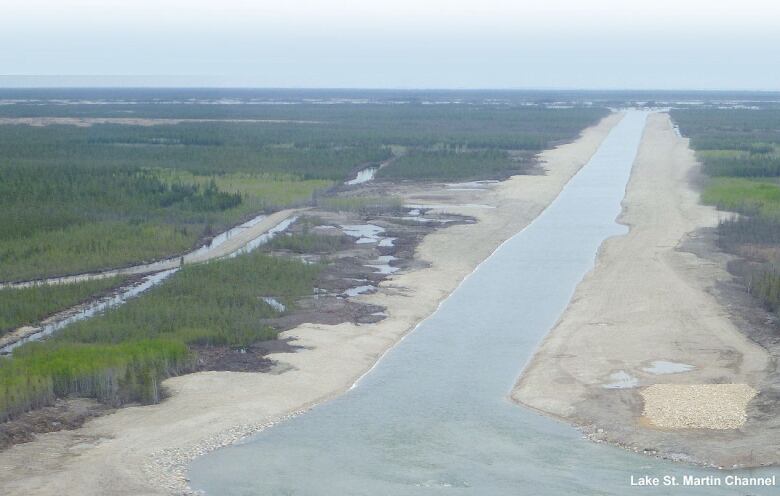Manitoba chiefs want 2011 flood evacuees home before $495M diversion built
Manitoba chiefs calling on province to halt construction until flood evacuees back in permanent homes
Traffic was held up on Highway 6 nearFairford, Man., Tuesday afternoon as a group of First Nations protestors rallied against a $495-million flood diversion plan for Lake Manitoba.
- Lake St. Martin flood evacuees protest being out of homes for 4 years
- Lake St. Martin flood evacuees could have new home by 2015
- Province eyes permanent Lake St. Martin flood channel
Chiefs, community members and even students gathered on the highway near the Fairford River Water Control Structure to call attention to the 1,900 flood evacuees who remain displaced after 2011 flooding in the area.

Protesters said they're not happy the Manitoba government has committed $495 million to flood mitigation in the area but has failed to secure permanent homes for the people who used to live there and were displaced by flooding four years ago.
On Tuesday, dozens of people walked down the highway, blocking traffic for much of the day and called on Manitobans to demand flood evacuees are returned to permanent homes before construction begins on the diversion channels.
"How much more lands? How much more natural resources are we going to give up to this government?" said Shorting. "No more."
Elder Bertha Sumner was displaced from Lake St. Martin First Nation in 2011.
"I saw people getting in the bus with just a little bag, just like we were going to stay for a week in the city. Nobody ever said anything about how long we were going to be gone," she said.
Not everyone was forced out of their homes, though, and some of the people who have remained in the area have now been told due to a high water table, their homes are growing mold.
Pinaymootang First Nation Chief Garnet Woodhouse said since 2011, a number of families in his community have learned their homes are no longer safe to live in.
"There are four families that were evacuated in November [due to] mold," he said.
According to the protesters, the province used the Portage Diversion, the Fairford Structure and the Shellmouth Dam to divert water from populated areas in southern Manitoba and avoid major flooding in those areas in spring 2011.
Instead, a number of First Nations were flooded, and evacuees remain displaced four years later.

Now, the group wants flood claims and compensation for the evacuees sorted out before construction on the flood channel begins.
"Before half a billion dollars is spent on a diversion in the Interlake, every man, woman and elder needs to be brought home to a safe community," said Assembly of Manitoba ChiefsGrand ChiefDerekNepinak.
Provincial officials released a statement in response Tuesday afternoon, saying they shared the goal of returning 2011 flood evacuees to their community as soon as possible.
"The province has set aside $100 million as part of a comprehensive settlement package and resettlement agreements have been signed with the four affected First Nations. Part of the resettlement process is mitigating the effects of possible future floods," the statement read in part. "The governments of Canada and Manitoba are jointly funding the Lake Manitoba and Lake St. Martin outlet channels, which will help protect residents of the First Nations communities in the Lake Manitoba basin from the impacts of chronic flooding."
The statement said discussions with First Nations on solutions are continuing.













_(720p).jpg)


 OFFICIAL HD MUSIC VIDEO.jpg)
.jpg)



























































































